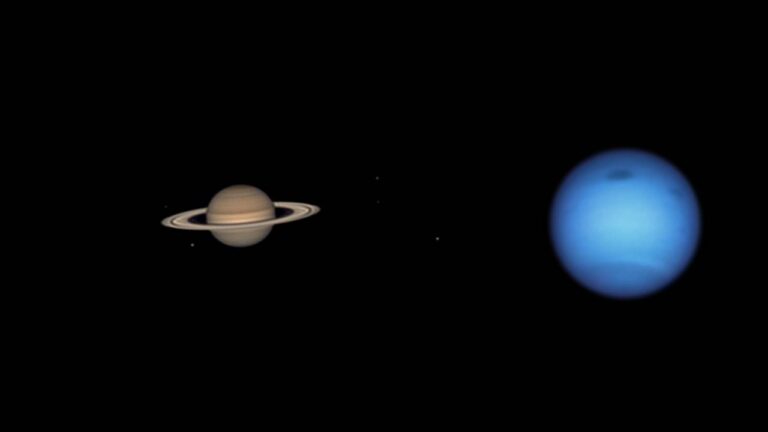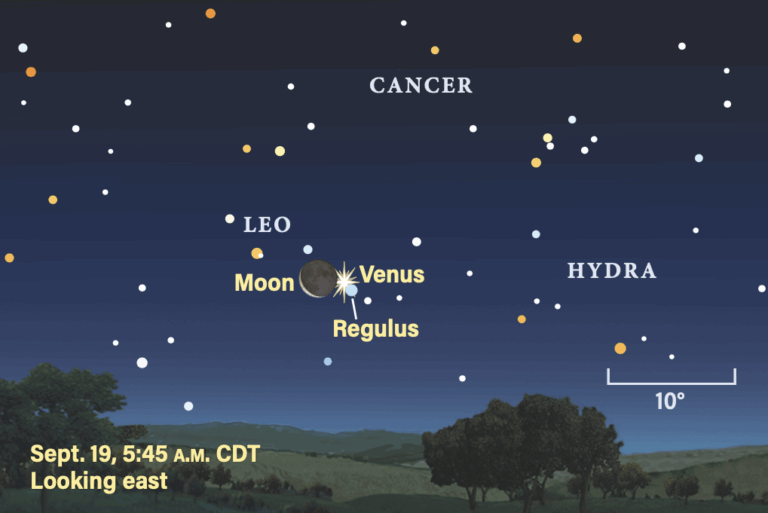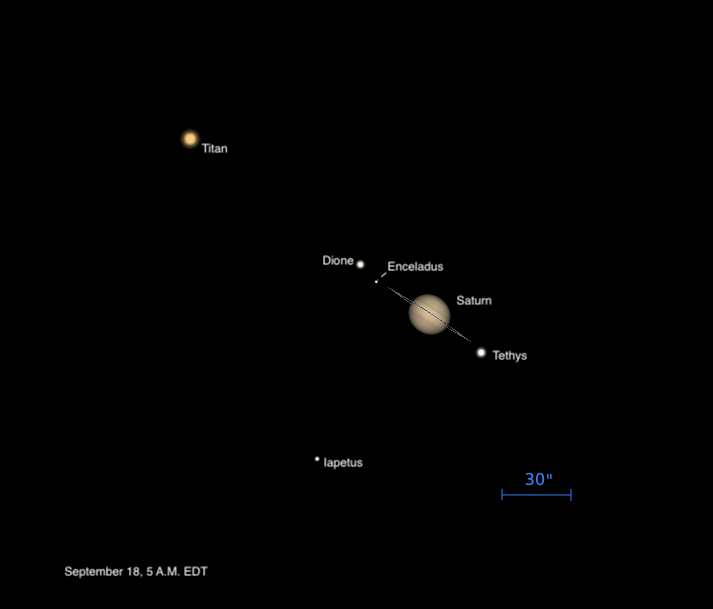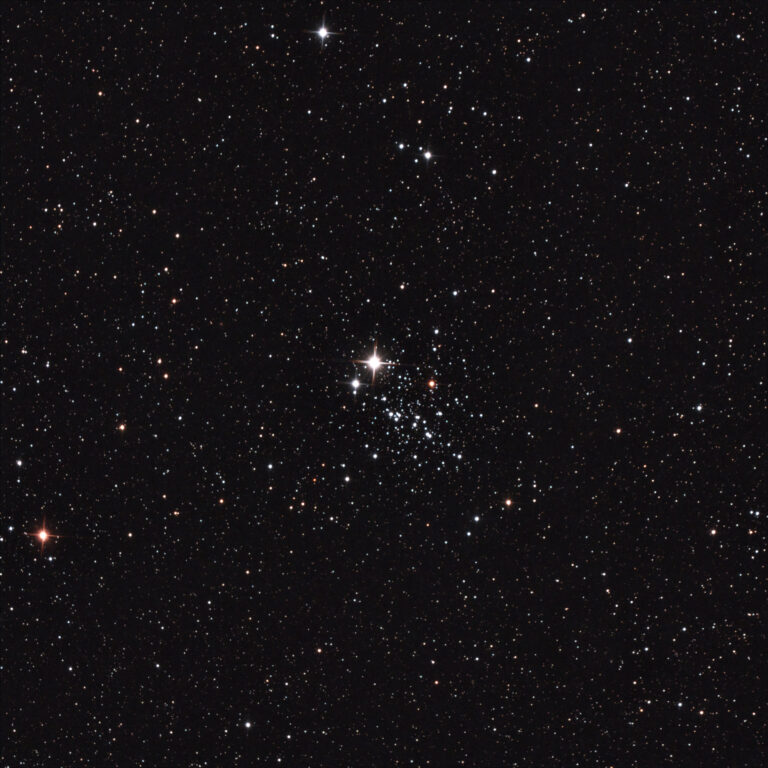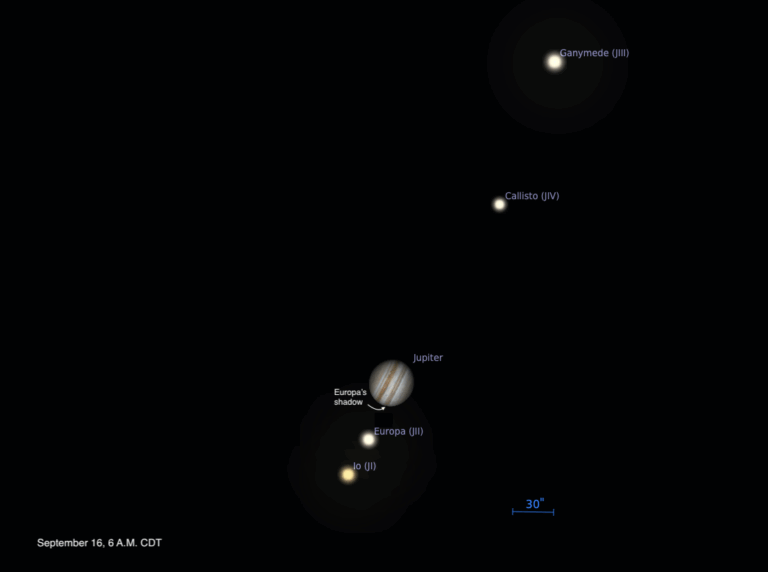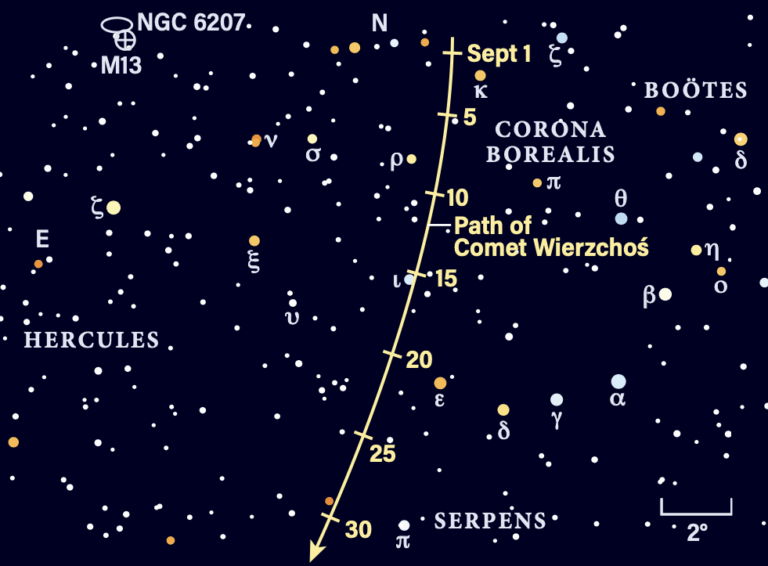Key Takeaways:
The waxing gibbous Moon stands 4° above magnitude –2.2 Jupiter as twilight fades to darkness. If you point a telescope at Jupiter, you’ll see spectacular cloud-top detail on a flattened disk that spans 39″ across the equator. You’ll also see the gas giant’s four brightest moons. These are just the biggest of Jupiter’s satellite entourage — earlier this week, astronomers announced the discovery of 12 more moons, bringing the planet’s total to a whopping 79.
Saturday, July 21
Perhaps no month better epitomizes summer in the Northern Hemisphere than July. And this month finds the season’s namesake asterism, the Summer Triangle, on prominent display. The trio’s brightest member, Vega in the constellation Lyra the Harp, stands nearly overhead shortly before midnight. The asterism’s second-brightest star, Altair in Aquila the Eagle, then lies more than halfway from the southeastern horizon to the zenith. Deneb, the luminary of Cygnus the Swan, marks the Summer Triangle’s third corner. Although it is this asterism’s dimmest star, it’s the brightest point of light in the entire northeastern sky.
Sunday, July 22
Observers of the outer solar system can get a good view of Uranus before dawn. The best time to look for it is between 2 and 4 a.m. local daylight time, after the Moon has set but before twilight commences. At 3 a.m., Uranus lies 30° above the eastern horizon, among the background stars of southwestern Aries the Ram. This morning, use binoculars to find the magnitude 5.8 planet 4.6° northeast of the 4th-magnitude star Omicron (ο) Piscium. A telescope reveals Uranus’ blue-green disk, which spans 3.5″.
The Southern Delta Aquariid meteor shower continues to ramp up this week. Although the shower won’t peak until the end of July, you should see some of its meteors in the hours before dawn. The best time to look this morning is between 2:30 and 4 a.m. local daylight time, in the 90-minute window between moonset and the beginning of twilight. Unfortunately, the Moon will show a waning gibbous phase at the shower’s peak the night of July 29/30. To tell a Southern Delta Aquariid meteor from a random dust particle burning up in Earth’s atmosphere, trace the streak of light’s path backward. A shower meteor will appear to originate from the constellation Aquarius the Water-bearer.
Tuesday, July 24
The waxing gibbous Moon passes just 2° north of Saturn tonight, helping point the way to the magnificent ringed planet. The two are on display nearly all night among the background stars of northern Sagittarius, hanging in the southeastern sky as darkness falls and climbing high in the south by 11 p.m. local daylight time. The pair will look nice with the naked eye or binoculars, but telescope users will want to target the magnitude 0.2 planet on another night this week when the Moon isn’t so close. Saturn reached its peak a month ago, when it appeared opposite the Sun in the sky, and our view of the ringed planet remains spectacular. A telescope reveals the world’s 18″-diameter disk surrounded by a dramatic ring system that spans 41″ and tilts 26° to our line of sight.
Wednesday, July 25
Venus dominates the western sky after sunset. The dazzling object shines at magnitude –4.3 among the background stars of southern Leo. The planet appears 11° high an hour after sundown and sets shortly after 10 p.m. local daylight time. When viewed through a telescope, Venus appears 19″ across and 60 percent lit.
Mars lies opposite the Sun in our sky tonight as it reaches peak visibility for 2018. The Red Planet appears low in the southeast as darkness falls and grows more prominent as the evening wears on and it climbs higher. By 1 a.m. local daylight time, it stands about 25° high in the south against the backdrop of stars in southwestern Capricornus. The world shines at magnitude –2.8, brighter than it has been in 15 years. When viewed through a telescope, the planet’s ocher-colored disk spans 24.2″, though you likely won’t see much surface detail because a global dust storm continues to choke the martian atmosphere. The Red Planet will come closest to Earth in four days, when its disk will appear 0.1″ larger than it does tonight.
Friday, July 27
Full Moon arrives at 4:20 p.m. EDT, and it dominates the sky all night. Our satellite appears Full when it lies opposite the Sun in our sky, just as Mars did yesterday, so you might expect the two to appear close to each other. You’d be right: The Full Moon lies 7° north of the Red Planet. Skywatchers in the Eastern Hemisphere get a bonus tonight as the Moon plunges through Earth’s shadow. Observers across most of Europe, Asia, Africa, and Australia will see a total lunar eclipse. Totality runs from 19h30m to 21h13m UT (that’s before dawn on the 28th for people in eastern Asia and Australia). The 103 minutes of totality make this the longest lunar eclipse since 2000.
Saturday, July 28
Asteroid 4 Vesta should be an easy target through binoculars or a telescope this weekend as the bright Moon moves away from the minor planet’s home in southern Ophiuchus. With binoculars, start at magnitude 2.4 Eta (η) Ophiuchi and then drop south one field to magnitude 4.4 Xi (ξ) Oph. This evening, magnitude 6.3 Vesta lies 1.7° southeast of Xi.
Sunday, July 29
The Big Dipper’s familiar shape appears halfway up the northwestern sky as darkness falls. One of the summer sky’s finest binocular double stars marks the bend of the Dipper’s handle. Mizar shines at 2nd magnitude, some six times brighter than its 4th-magnitude companion, Alcor. Even though these two are not physically related, they make a fine sight through binoculars. (People with good eyesight often can split the pair without optical aid.) A small telescope reveals Mizar itself as double — and these components do orbit each other.




